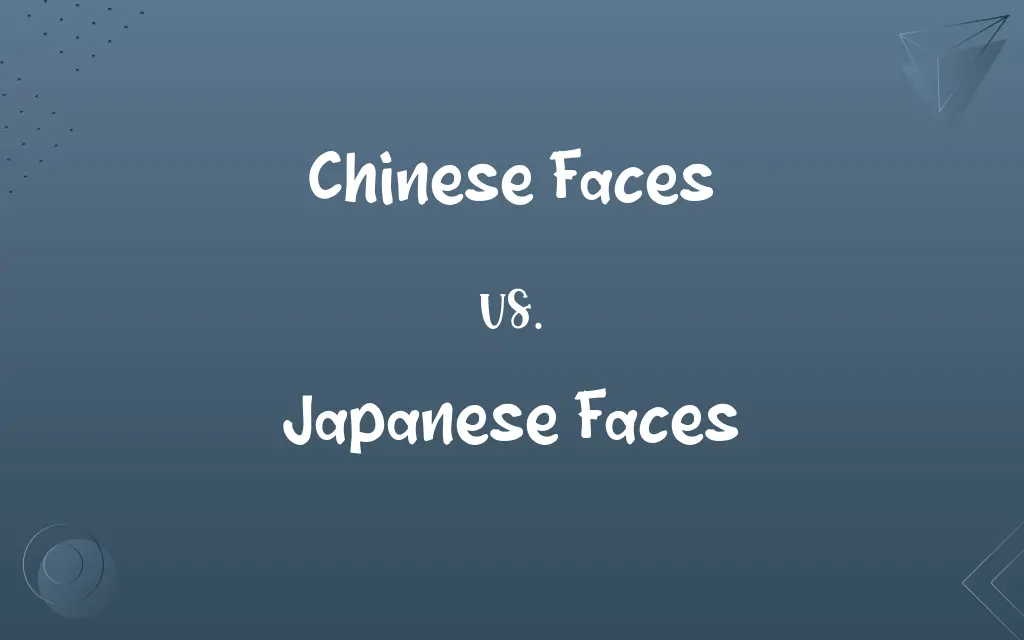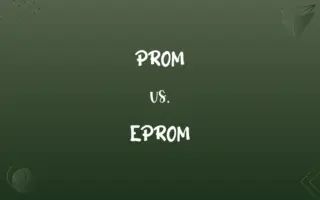Chinese Faces vs. Japanese Faces: Know the Difference

By Shumaila Saeed || Published on March 4, 2024
Chinese Faces and Japanese Faces refer to distinctive facial features historically associated with Chinese and Japanese populations, respectively, though such distinctions are broad generalizations.

Key Differences
Chinese Faces often refer to facial characteristics commonly attributed to people of Chinese heritage, which can include a wider variety of facial shapes and features due to China's vast geographic and ethnic diversity. In contrast, Japanese Faces typically refer to features associated with people of Japanese descent, who may exhibit more homogeneity in facial characteristics due to Japan's insular history.
Shumaila Saeed
Mar 04, 2024
In discussing Chinese Faces, it's important to consider China's multi-ethnic composition, which contributes to a broader spectrum of facial features. Japanese Faces, on the other hand, are generally thought to reflect a more uniform set of features, influenced by Japan's relatively isolated genetic pool.
Shumaila Saeed
Mar 04, 2024
When analyzing Chinese Faces, one might observe variations in eye shape, skin tone, and facial structure, reflecting the country's diverse ethnic groups. In contrast, Japanese Faces are often characterized by a more consistent set of features, shaped by Japan's predominantly ethnic Japanese population.
Shumaila Saeed
Mar 04, 2024
The concept of Chinese Faces encompasses the facial characteristics of over 50 recognized ethnic groups in China, leading to a rich diversity in appearances. Japanese Faces, while diverse in their own right, tend to show less variation due to the predominance of a single ethnic group throughout the country's history.
Shumaila Saeed
Mar 04, 2024
Chinese Faces and Japanese Faces, as concepts, are simplifications that don’t account for individual diversity or the effects of globalization, which have blurred these traditional distinctions. Both terms are generalizations and should be understood within the context of cultural diversity and individual uniqueness.
Shumaila Saeed
Mar 04, 2024
ADVERTISEMENT
Comparison Chart
Geographic Origin
China, a vast country with diverse regions and ethnicities
Japan, an island nation with a more homogeneous population
Shumaila Saeed
Mar 04, 2024
Ethnic Diversity
Represents over 50 ethnic groups with varied features
Largely represents a single ethnic group with more consistent features
Shumaila Saeed
Mar 04, 2024
Facial Feature Variation
Broader spectrum of facial shapes and sizes
Generally more uniform facial shapes and sizes
Shumaila Saeed
Mar 04, 2024
Cultural Influences
Influenced by a multitude of regional cultures
Influenced primarily by a singular, insular culture
Shumaila Saeed
Mar 04, 2024
Globalization Impact
Shows a mix of features due to historic migrations and diversity
Exhibits less variation, though modern influences are increasing
Shumaila Saeed
Mar 04, 2024
ADVERTISEMENT
Chinese Faces and Japanese Faces Definitions
Chinese Faces
Facial characteristics typically associated with people from China.
Her Chinese Faces reflected her Han Chinese heritage.
Shumaila Saeed
Jan 21, 2024
Japanese Faces
The physical appearance of someone's face indicating Japanese ancestry.
In the international gathering, his Japanese Faces stood out.
Shumaila Saeed
Jan 21, 2024
Chinese Faces
A generalized description of facial traits common to people of Chinese descent.
The painting captured the distinct Chinese Faces of the subjects.
Shumaila Saeed
Jan 21, 2024
Japanese Faces
A cultural symbol representing Japanese ethnic identity through facial traits.
The portrait highlighted the serene Japanese Faces, evoking a sense of cultural pride.
Shumaila Saeed
Jan 21, 2024
Chinese Faces
The physical appearance of someone's face that suggests Chinese ancestry.
His Chinese Faces made him a subject of interest in the international conference.
Shumaila Saeed
Jan 21, 2024
ADVERTISEMENT
Japanese Faces
A generalized term for the facial characteristics typical of people from Japan.
The actor was chosen for his distinctly Japanese Faces, fitting the character's background.
Shumaila Saeed
Jan 21, 2024
Chinese Faces
A term representing the diverse range of facial features among China's ethnic groups.
In the crowd, various Chinese Faces represented China's ethnic mosaic.
Shumaila Saeed
Jan 21, 2024
Japanese Faces
Facial features commonly attributed to individuals of Japanese origin.
Her Japanese Faces were a reflection of her family's long history in Kyoto.
Shumaila Saeed
Jan 21, 2024
Chinese Faces
A cultural representation of Chinese identity through facial features.
The sculpture showcased the unique Chinese Faces from different dynasties.
Shumaila Saeed
Jan 21, 2024
Japanese Faces
A representation of Japan's homogeneous ethnic composition through facial features.
The documentary on Japan showcased a variety of Japanese Faces from different regions.
Shumaila Saeed
Jan 21, 2024
Repeatedly Asked Queries
Do Chinese Faces indicate a single ethnic group?
No, Chinese Faces represent a variety of facial features from over 50 ethnic groups in China.
Shumaila Saeed
Mar 04, 2024
Are Japanese Faces diverse?
Japanese Faces tend to be less diverse, reflecting the homogeneity of Japan's ethnic population.
Shumaila Saeed
Mar 04, 2024
What are Japanese Faces?
Japanese Faces are the facial characteristics commonly seen in individuals from Japan.
Shumaila Saeed
Mar 04, 2024
Can you identify nationality by Chinese or Japanese Faces?
No, it's a generalization and doesn't accurately determine nationality.
Shumaila Saeed
Mar 04, 2024
Are Japanese Faces influenced by cultural factors?
Yes, historical and cultural factors have shaped the common characteristics of Japanese Faces.
Shumaila Saeed
Mar 04, 2024
What are Chinese Faces?
Chinese Faces refer to the typical facial features associated with people of Chinese descent.
Shumaila Saeed
Mar 04, 2024
Is there a standard look for Japanese Faces?
While there's no standard, certain facial traits are more commonly associated with Japanese heritage.
Shumaila Saeed
Mar 04, 2024
What role does genetics play in Chinese Faces?
Genetics plays a significant role, reflecting the diverse ethnic makeup of China.
Shumaila Saeed
Mar 04, 2024
Do Chinese Faces differ regionally within China?
Yes, Chinese Faces can vary significantly across different regions in China.
Shumaila Saeed
Mar 04, 2024
Can Chinese and Japanese Faces be distinguished easily?
Not always, as individual features can vary widely regardless of national origin.
Shumaila Saeed
Mar 04, 2024
Does globalization affect the concept of Chinese Faces?
Yes, globalization has introduced more diversity and complexity to the concept of Chinese Faces.
Shumaila Saeed
Mar 04, 2024
How significant is genetics in determining Japanese Faces?
Genetics is quite significant, due to Japan's relatively homogenous genetic history.
Shumaila Saeed
Mar 04, 2024
How does ethnicity affect Chinese Faces?
Ethnic background greatly influences the variation in Chinese facial features.
Shumaila Saeed
Mar 04, 2024
Do Japanese Faces reflect regional differences within Japan?
To a lesser extent than in China, as Japan has a more uniform ethnic composition.
Shumaila Saeed
Mar 04, 2024
Are Japanese Faces changing due to global influences?
Yes, global influences are gradually introducing more diversity in Japanese Faces.
Shumaila Saeed
Mar 04, 2024
Can Chinese Faces be linked to specific regions in China?
In some cases, yes, as certain regions have distinct ethnic groups with unique features.
Shumaila Saeed
Mar 04, 2024
Share this page
Link for your blog / website
HTML
Link to share via messenger
About Author
Written by
Shumaila SaeedShumaila Saeed, an expert content creator with 6 years of experience, specializes in distilling complex topics into easily digestible comparisons, shining a light on the nuances that both inform and educate readers with clarity and accuracy.








































































